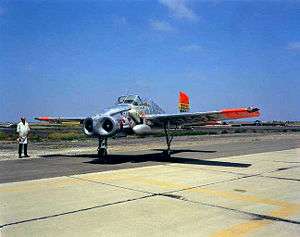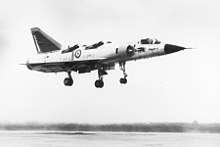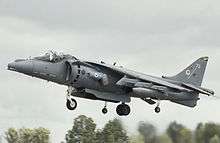Ground effect (aerodynamics)
For fixed-wing aircraft, ground effect is the increased lift and decreased aerodynamic drag that an aircraft's wings generate when they are close to a fixed surface.[1] When landing, ground effect can give the pilot the feeling that the aircraft is "floating". When taking off, ground effect may temporarily reduce the stall speed. The pilot can then fly just above the runway while the aircraft accelerates in ground effect until a safe climb speed is reached.[2]
For rotorcraft, ground effect results in more power being available during hovering which allows heavier weights to be lifted. Helicopter pilots are provided with performance charts which show the limitations for hovering their helicopter in ground effect (IGE) and out of ground effect (OGE). The charts show the added lift benefit produced by ground effect.[3]
For fan- and jet-powered VTOL aircraft, ground effect when hovering can cause suckdown and fountain lift on the airframe and loss in hovering thrust if the engine sucks in its own exhaust gas, which is known as hot gas ingestion (HGI).[4]
Explanations
Fixed wing aircraft
When an aircraft flies at a ground level approximately at or below the half length of the aircraft's wingspan there occurs, depending on airfoil and aircraft design, an often noticeable ground effect. This is caused primarily by the ground interrupting the wingtip vortices and downwash behind the wing. When a wing is flown very close to the ground, wingtip vortices are unable to form effectively due to the obstruction of the ground. The result is lower induced drag, which increases the speed and lift of the aircraft.[5][6]
A wing generates lift by deflecting the oncoming airmass (relative wind) downward.[7] The deflected or "turned" flow of air creates a resultant force on the wing in the opposite direction (Newton's 3rd law). The resultant force is identified as lift. Flying close to a surface increases air pressure on the lower wing surface, nicknamed the "ram" or "cushion" effect, and thereby improves the aircraft lift-to-drag ratio. The lower/nearer the wing is with regards to the ground, the more pronounced the ground effect becomes. While in the ground effect, the wing requires a lower angle of attack to produce the same amount of lift. If the angle of attack and velocity remain constant, an increase in the lift coefficient ensues,[8] which accounts for the "floating" effect. Ground effect also alters thrust versus velocity, where reduced induced drag requires less thrust in order to maintain the same velocity.[8]
Low winged aircraft are more affected by ground effect than high wing aircraft.[9] Due to the change in up-wash, down-wash, and wingtip vortices there may be errors in the airspeed system while in ground effect due to changes in the local pressure at the static source.[8]
Rotorcraft
When a hovering rotor is near the ground the downward flow of air through the rotor is reduced to zero at the ground. This condition is transferred up to the disc through pressure changes in the wake which decreases the inflow to the rotor for a given disk loading, which is rotor thrust for each square foot of its area. This gives a thrust increase for a particular blade pitch angle. Or, alternatively, the power required for a thrust is reduced. For an overloaded helicopter that can only hover IGE it may be possible to climb away from the ground by translating to forward flight first while in ground effect.[10] The ground effect benefit disappears rapidly with speed but the induced power decreases rapidly as well to allow a safe climb.[11] Some early underpowered helicopters could only hover close to the ground.[12] Ground effect is at its maximum over a firm, smooth surface.[13]
VTOL aircraft
There are two effects inherent to VTOL aircraft operating at zero and low speeds IGE, suckdown and fountain lift. A third, HGI, may also apply to fixed-wing aircraft on the ground in windy conditions or during thrust reverser operation. How well, in terms of weight lifted, a VTOL aircraft hovers IGE depends on suckdown on the airframe, fountain impingement on the underside of the fuselage and HGI into the engine. Suckdown works against the engine lift as a downward force on the airframe. Fountain flow works with the engine lift jets as an upwards force. HGI reduces the thrust generated by the engine.
Suckdown is the result of entrainment of air around aircraft by lift jets when hovering. It also occurs in free air (OGE) causing loss of lift by reducing pressures on the underside of the fuselage and wings. Enhanced entrainment occurs when close to the ground giving higher lift loss. Fountain lift occurs when an aircraft has two or more lift jets. The jets strike the ground and spread out. Where they meet under the fuselage they mix and can only move upwards striking the underside of the fuselage.[14] How well their upward momentum is diverted sideways or downward determines the lift. Fountain flow follows a curved fuselage underbody and retains some momentum in an upward direction so less than full fountain lift is captured unless Lift Improvement Devices are fitted.[15] HGI reduces engine thrust because the air entering the engine is hotter than ambient.
Early VTOL experimental aircraft operated from open grids to channel away the engine exhaust and prevent thrust loss from HGI.
The Bell X-14, built to research early VTOL technology, was unable to hover until suckdown effects were reduced by raising the aircraft with longer landing gear legs.[16] It also had to operate from an elevated platform of perforated steel to reduce HGI.[17] The Dassault Mirage IIIV VTOL research aircraft only ever operated vertically from a grid which allowed engine exhaust to be channelled away from the aircraft to avoid suckdown and HGI effects.[18]
Ventral strakes retroactively fitted to the P.1127 improved flow and increased pressure under the belly in low altitude hovering. Gun pods fitted in the same position did the same thing. Further lift improvement devices (LIDS) were developed for the AV-8B and Harrier II. To box in the belly region where the lift-enhancing fountains strike the aircraft strakes were added to the underside of the gun pods and a hinged dam could be lowered to block the gap between the front ends of the strakes. This gave a 1200 lb lift gain.[19]
Lockheed Martin F-35 Lightning II weapons-bay inboard doors on the F-35B open to capture fountain flow created by the engine and fan lift jets and counter suckdown IGE.
 Bell X-14 showing lengthened landing gear legs to reduce suckdown
Bell X-14 showing lengthened landing gear legs to reduce suckdown Dassault Mirage IIIV hovering over open grid
Dassault Mirage IIIV hovering over open grid.jpg) Underside view of the first prototype P.1127 showing small ventral strakes to increase fountain lift
Underside view of the first prototype P.1127 showing small ventral strakes to increase fountain lift Harrier GR9 showing the Lift Improvement Devices, large ventral strakes and a retractable dam behind nosewheel
Harrier GR9 showing the Lift Improvement Devices, large ventral strakes and a retractable dam behind nosewheel F-35B showing weapon's bay inboard doors open to capture rising fountain flow
F-35B showing weapon's bay inboard doors open to capture rising fountain flow
Wing stall in ground effect
The stalling angle of attack is less in ground effect, by approximately 2-4 degrees, than in free air.[20][21] When the flow separates there is a large increase in drag. If the aircraft overrotates on take-off at too low a speed the increased drag can prevent the aircraft from leaving the ground. Two de Havilland Comets overran the end of the runway after overrotating.[22][23] Loss of control may occur if one wing tip stalls in ground effect. During certification testing of the Gulfstream G650 business jet the test aircraft rotated to an angle beyond the predicted IGE stalling angle. The over-rotation caused one wing-tip to stall and an uncommanded roll, which overpowered the lateral controls, led to loss of the aircraft.[24][25]
Ground-effect vehicle
A few vehicles have been designed to explore the performance advantages of flying in ground effect, mainly over water. The operational disadvantages of flying very close to the surface have discouraged widespread applications.[26]
References
Notes
- Gleim 1982, p. 94.
- Dole 2000, p. 70.
- https://www.faa.gov/regulations_policies/handbooks_manuals/aviation/helicopter_flying_handbook/media/hfh_ch07.pdf
- https://soaneemrana.org/onewebmedia/AIRCRAFT%20DESIGN%20%3B%20A%20Conceptual%20Approach%20BY%20DANIEL%20P%20RAYMER.pdf Archived 2019-07-04 at the Wayback Machine Section 20.6
- Aerodynamics for Naval Aviators. RAMESH TAAL, HOSUR, VIC. Australia: Aviation Theory Centre, 2005.
- Pilot's Encyclopedia of Aeronautical Knowledge 2007, pp. 3-7, 3-8.
- "Lift from Flow Turning". NASA Glenn Research Center. Retrieved July 7, 2009.
- Dole 2000, pp. 3–8.
- Flight theory and aerodynamics, p. 70
- https://archive.org/details/DTIC_ADA002007 3-2.1.1.8
- https://www.abbottaerospace.com/downloads/agard-r-781/, p.2-6
- Basic Helicopter Aerodynamics, J. Seddon 1990, ISBN 0 632 02032 6, p.21
- https://rotorcraft.arc.nasa.gov/faa-h-8083-21.pdf Archived 2016-12-27 at the Wayback Machine p.3-4
- https://soaneemrana.org/onewebmedia/AIRCRAFT%20DESIGN%20%3B%20A%20Conceptual%20Approach%20BY%20DANIEL%20P%20RAYMER.pdf Archived 2019-07-04 at the Wayback Machine, p.551,552
- https://www.ntrs.nasa.gov/search.jsp?R=19870014977&qs=t%3D0%26N%3D4294955891%2B4294904888%2B4294965980%5B%5D, p.4
- The X-Planes, Jay Miller1988, ISBN 0 517 56749 0, p.108
- https://www.semanticscholar.org/paper/Application-of-powered-high-lift-systems-to-STOL-Ameel/d77cdbba3fea3a81678bb76f9070ac2ee546bd55, p.14
- https://catalog.princeton.edu/catalog/5869200, p.4
- Harrier Modern Combat Aircraft 13, Bill Gunston1981, ISBN 0 7110 1071 4, p.23,43,101
- "The NTSB’s John O’Callaghan, a national resource specialist in aircraft performance, noted that all aircraft stall at approximately 2-4 deg. lower AOA [angle of attack] with the wheels on the ground." (from NTSB Accident Report concerning loss of a sweptwing business-class jet airplane in April 2011) Thin Margins in Wintry Takeoffs AWST, 24 December 2018
- https://aviation-safety.net/database/record.php?id=19530303-1
- Aerodynamic Design Of Transport Aircraft, Ed Obert 2009, ISBN 978 1 58603 970 7, p.603-606
- https://www.flightsafetyaustralia.com/2019/10/reprise-night-of-the-comet/
- https://www.ntsb.gov/investigations/AccidentReports/Pages/AAR1202.aspx
- From NTSB Accident Report: Flight test reports noted “post stall roll-off is abrupt and will saturate lateral control power.” The catastrophic unrecoverable roll of the aircraft in the Roswell accident was due in part to the absence of warning before the stall in ground effect.
- Understanding Aerodynamics - Arguing From The Real Physics, Doug McLean 2013, ISBN 978 1 119 96751 4, p.401
Bibliography
- Dole, Charles Edward. Flight Theory and Aerodynamics. Hoboken, New Jersey: John Wiley & Sons, Inc., 2000. ISBN 978-0-471-37006-2.
- Gleim, Irving. Pilot Flight Maneuvers. Ottawa, Ontario, Canada: Aviation Publications, 1982. ISBN 0-917539-00-1.
- Pilot's Encyclopedia of Aeronautical Knowledge (Federal Aviation Administration). New York: Skyhorse Publishing, 2007. ISBN 1-60239-034-7.
External links
| Wikimedia Commons has media related to Ground effect. |
- Engineering explanation. SE-Technology ('dead' site)
- Ask Us – Ground Effect and WIG Vehicles. Aerospaceweb.org
- M. Halloran and S. O'Meara (February 1999). "Wing in Ground Effect Craft Review" (PDF-9 MB). The Sir Lawrence Wackett Centre for Aerospace Design Technology, Royal Melbourne Institute of Technology – via Abbott Aerospace.CS1 maint: uses authors parameter (link) DSTO-GD-0201. Sponsored by DSTO Aeronautical and Maritime Research Laboratory, Australian Government. (WebArchive)
- Wing in Ground Effect and helicopters. dynamicflight.com
- Plane Can Fly Inches Over Water Tongji University Scientists in Shanghai announce design of a new vehicle, inventorspot.com, 14 July 2007
- Ground-effect gliding. hanggliding.org
- Numerical Analysis of Airfoil in Ground Proximity Journal of Theoretical and Applied Mechanics, 45, 2, pp. 425–36, Warsaw 2007. ptmts.org. PDF-715 KB